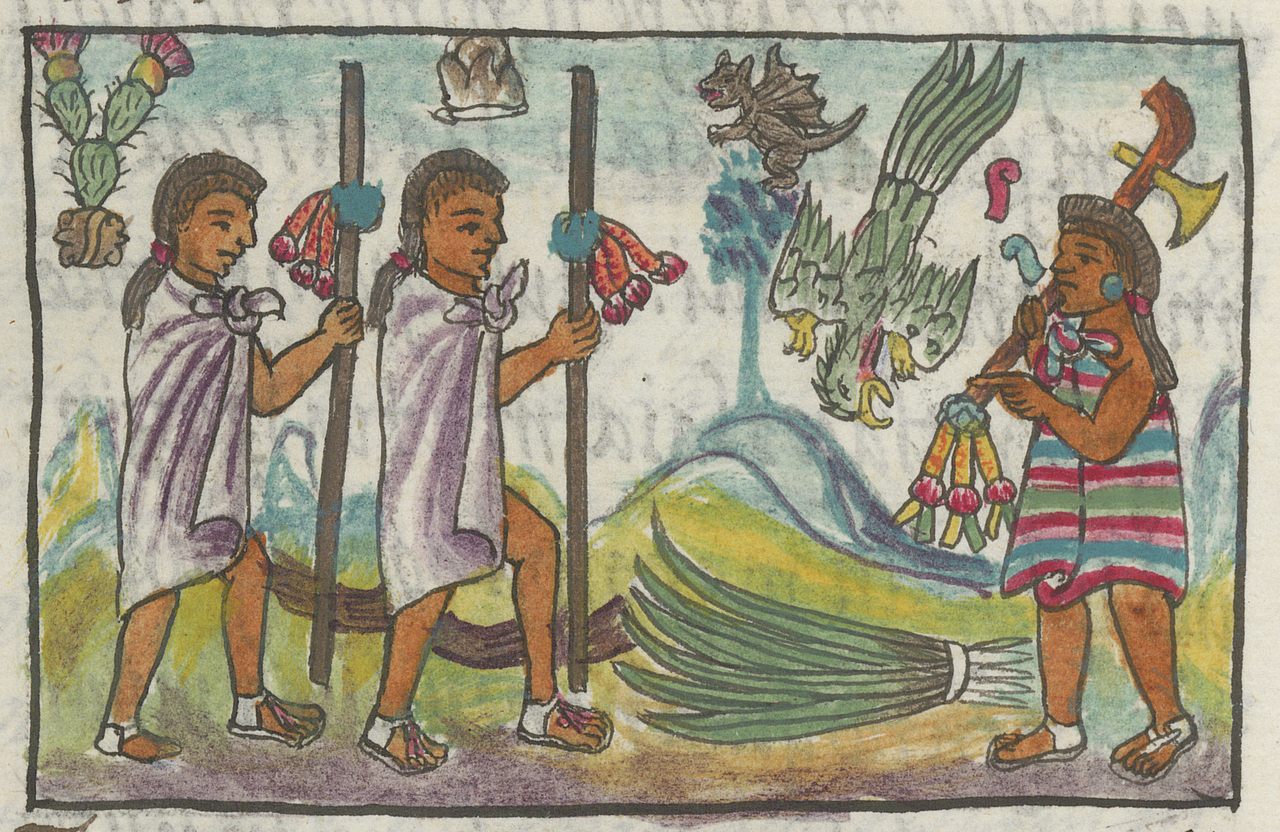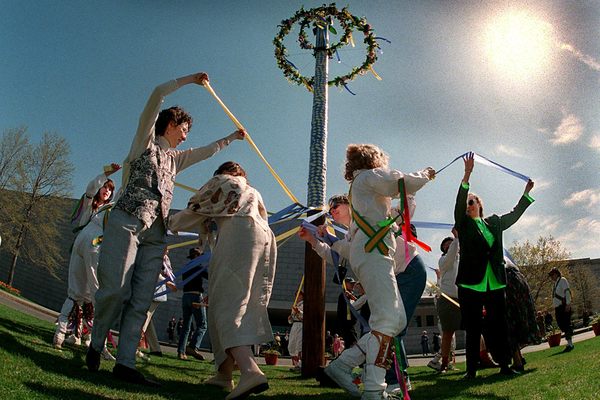A 500-Year-Old Record of the Aztec Empire Comes to Life
The Digital Florentine Codex’s three languages and thousands of hand-painted illustrations provide a window into culture, war, and daily life.
What comes to mind when you imagine the Aztec Empire? It doesn’t quite generate the obsession that the Roman Empire might, but perhaps pyramids? Warriors? Or, more likely, its decimation at the hands of Spanish conquistadors. That’s probably because so much of what is widely known about the Aztecs is filtered through those European conquerors. But 16th century central Mexico, where the Aztec Empire thrived then fell, was lively with history, cuisine, medicine, and culture, and that world is now more accessible than it has been for centuries.
The Florentine Codex—named for its place in the Biblioteca Medicea Laurenziana in Florence, Italy—is considered the most reliable source of information about this time and place. The 2,500-page manuscript was completed in 1577, a generation after the Spanish conquest, in Tlatelolco, today part of Mexico City. The text holds a wealth of information on the Aztec Empire, pre- and early-colonial culture, and the Mexica—one of the three groups of Indigenous Nahua peoples that ruled the Aztec Empire—including their perspective on the Spanish conquest. The book is a beautiful and incredibly thorough record—with nearly 2,500 illustrations—but it has historically been difficult to access and interpret, according to Alicia Maria Houtrouw, a project manager at the Getty Research Institute. In October 2023, the Los Angeles–based institute—and a multitude of partners—published an online edition of the codex for researchers, teachers, and the public to access easily, along with updated summaries in modern Nahuatl, Spanish, and English.
“It is impossible to overstate the importance of the Florentine Codex,” says senior research specialist Kim Richter, the principal lead of the Florentine Codex Initiative at the Getty Research Institute.

In 1547 in central Mexico, Spanish Franciscan friar Bernardino de Sahagún began compiling information about Nahua culture, history, flora and fauna, astronomy, daily life, and more, including the Nahuatl language. His mission wasn’t altruistic. “His primary goal was to convert Indigenous peoples to Christianity,” says Houtrouw. “But he strongly believed that to do so you needed to understand the people, the language, and the culture.” While Sahagún is often credited for the text, countless Nahua elders, scribes, and grammarians—and at least 20 Nahua artists—contributed to the project.
The contents were first written in Nahuatl—with context-rich images supplying additional stories—and then paraphrased in Spanish in adjacent columns. The two sections are “complementary, but distinct,” says Houtrouw. These texts are not only incredibly valuable on their own—especially the first-hand Nahua accounts—but revealing of the interplay of clashing cultures at a unique point in history. “As a transcultural manuscript, it bridges two worlds,” says Richter. “And in this sense, it is deeply relevant today, when many people straddle and negotiate two or more cultures.”
The codex is modeled after medieval encyclopedias, detailing Indigenous perspectives on the Spanish conquest, and also a vast array of information on everything from a bloody and chaotic solar eclipse tradition, to the good fortune of hearing the laughing cry of the huactil bird, to a cure for split ends, made of herbs and urine. And the codex is at home in the kitchen, too. It is the primary window into precolonial cuisine in Mexico, predating the first cookbook from Mexico, which dates to the 19th-century. A reader might find maize porridge with honey, tadpoles, and locusts with chía. But eat slowly: If you choke, it is said you will be laughed at and offered more food for your gluttony. The codex also covers the agricultural methods of the time, such as the floating gardens, or chinampas, of the Aztec Empire, which still serve as an agricultural model today.

In 1577, the codex was sent to Spain, where it eventually found its way to Rome and then Florence. The text was widely forgotten until the 19th century, when scholars began to take interest in it. In the 20th century, several academics started translating the text to Spanish and English, but their summaries were contained in massive and expensive volumes. The codex earned a place in UNESCO’s Memory of the World Register in 2015. A few years earlier, the codex had been published online via the World Digital Library, but the text remained all but inaccessible. “Unless you are comfortable reading 16th-century handwriting in classical Nahuatl and Spanish—both of which have changed quite a bit in 500 years—the codex is very difficult to understand,” says Houtrouw. “What we’re doing with this project is really addressing that question of access.” In 2016, the Getty Research Institute partnered with the Biblioteca Medicea Laurenziana and a cross-disciplinary team of more than 65 researchers, Nahuatl language experts, Mexican and Spanish colonial history scholars, and software engineers across institutions in Italy, Mexico, and the United States to bring the text to life and to the world.
The Digital Florentine Codex homepage includes titles for each of the 12 books, which focus on a range of topics, from gods, festivals, and astrology to occupations, animals, and everyday life. If you have an idea of what you’re looking for, or want to try something random, the search bar at the top will take you right to relevant illustrations or text in Nahuatl, Spanish, or English. Don’t be afraid to play around. “Sports” won’t get you far, but “ball” brings up a plethora of Aztec games and athletic activities such as tlachtli, a ritual ball game. “They would not use their hands to play, but they would hit the ball instead with their buttocks,” according to the codex’s Spanish-to-English translation.

Regardless of which codex rabbithole you find yourself down, the work’s new online home and translation is more than just a curiosity—it is an invaluable resource for the preservation of culture, language, and history. For the 1.5 million speakers of the endangered Nahuatl language today, it is a linguistic treasure and cultural resource that still holds great relevance. “I kept thinking about how today in certain places in Mexico there is violence against Indigenous peoples,” said Eduardo de la Cruz Cruz, director of the Instituto de Docencia e Investigación Etnológica de Zacatecas, an institution dedicated to teaching and revitalizing the Nahuatl language, in a release. “Working on projects like this gives me hope that they can foster greater knowledge, awareness, and appreciation of Nahua culture, which is so integral to the Mexican national identity.” Cruz Cruz also provided the modern Nahuatl summaries of each chapter. Book 12, for example, is the longest historical account of the conquest written in Nahuatl, and now can be found alongside Cruz Cruz’s audio summary in the modern version of the language.
Book 12 covers the arrival of Spaniards in 1519 to present day Mexico, as well as the war on Tenochtitlan and Tlatelolco, the Mexica capital of the Aztec Empire and its neighboring sister city, from 1520 to 1521. There is a great contrast between the Nahua and Spanish translations in this book. The Spanish columns are shorter, and leave out details such as the heroic achievements of Mexica warriors, the more atrocious acts of Spanish conquistadors and their Indigenous allies, and gruesome details from battle. The Nahuatl record, on the other hand, illuminates an Indigenous perspective that has largely been left out of the telling of the conquest. The Getty Research Institute is working on an additional review of Book 12 to further highlight these accounts.

Cruz Cruz and other educators are using the newly accessible text to bring these perspectives to the classroom. In 2019, during the 500-year anniversary of the Spanish conquest, a codirector on the codex digitization project, Kevin Terraciano—a professor of history at the University of California, Los Angeles—led a workshop for teachers on how to use the text to teach history through an Indigenous lens. Now Terraciano is creating courses for his university students to explore the codex in all its glory. “There’s no need to just focus on Book 12,” he says. “If you want to instead focus on plants, or a particular animal, or on a particular god, really the sky’s the limit.”
With the user-friendly online platform, anyone can explore the work. “Our main mission is to open the codex to everyone and to facilitate the process of discovery,” says Houtrouw. “Whatever someone is interested in—whether it be medicinal plants or Mexica ritual practices—they are bound to find something relevant in the codex.”





























Follow us on Twitter to get the latest on the world's hidden wonders.
Like us on Facebook to get the latest on the world's hidden wonders.
Follow us on Twitter Like us on Facebook